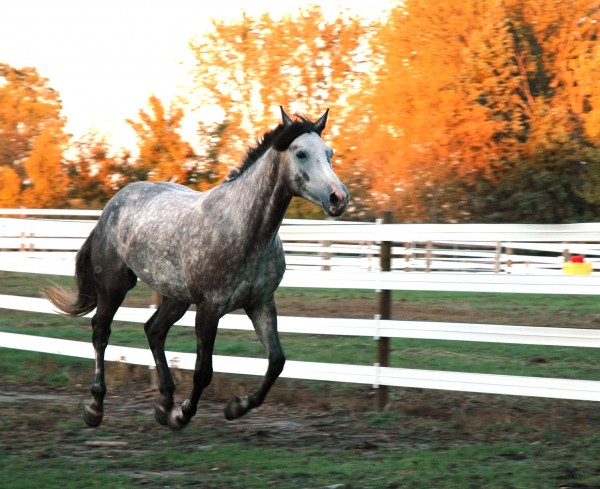Feeding “George”: A Polysaccharide Storage Myopathy (PSSM) Horse

Previously, I introduced you to George, my “Heinz-57” PSSM positive horse. Though his test results came back positive for Type 1 PSSM, his diagnosis does not mean his athletic career is over. With some diligence and routine, George is able to lead a normal life as a successful working partner.
One key to managing his condition is maintaining consistency in his diet and routine. Remember, he would get sore every time the hay changed, particularly if it had alfalfa in it. First I work to ensure that George’s total diet is properly balanced which starts with controlling the starch and sugar energy sources in his hay and grain ration. I buy larger quantities of grass hay (no alfalfa) that will last awhile, a full year if possible. I also have my hay tested before buying it to make sure it isn’t too high in non-structural carbohydrates (12% NSC or less), and that the rest of the nutrients are within an acceptable range for good quality hay, as this is the bulk of his diet. The lower the NSC in the hay, the more room there is in the diet to add calories from fat. More on that below.
To balance his hay, he gets a controlled starch feed concentrate that is fortified with essential amino acids, complexed trace minerals, pre- and probiotics. If I need to add calories to his diet to support higher levels of exertion during training and show season, I add a balanced fat supplement to the concentrate component of his diet. To meet the total caloric requirement it is recommended that PSSM positive horses receive no more than 10% of the digestible energy from non-structural carbohydrates (starch and sugar), and 15-20% of the digestible energy should be supplied by fat. Remember, this applies to the total diet, contributions from grain plus forage. Working with a qualified equine nutritionist is a great way to figure all of this out. In a nutshell, I control the sugars and starches in his total diet (low NSC grass hay and low calorie, controlled NSC grain) and add a nutritionally balanced fat source when extra calories are needed. The only supplement he gets is vitamin E, which helps boost his antioxidant status (helps fight oxidative stress), and supports muscle recovery after exercise. Because his total diet is balanced for selenium, I don’t supplement this mineral to avoid potential toxicity.
Estimating his weight and doing a regular body condition score help me adjust his diet and exercise routine accordingly, so he maintains good muscle mass and avoids excess fat deposits. In addition, I make sure to minimize stress as much as possible by keeping his routine consistent. His daily ration is divided up into 3 meals to avoid one large grain meal and he has access to hay for most of the day. He gets a minimum turnout of 8 hours every day with a buddy and limited access to fresh forage. I also exercise him at least 6 days a week. With this management routine, regular veterinary and farrier care, he has never “tied-up” on me, and continues to excel in dressage with the occasional hunter pace thrown into the mix. Providing good quality of life is a top priority, especially when it comes to managing even the most challenging horses, and I think George would agree, he is doing great!
